
If you’re an experienced recording engineer who’s recently launched their own music studio or is currently getting it off the ground, designing a sleek and striking website is your best chance to promote your new business, as well as separate you from the rest of the pack. A beautifully designed music studio website is your opportunity to strike a chord with potential customers. In this day and age where virtual first impressions can be the difference between success and failure, you need to make sure your online presence is up to date and cutting edge.
Here are ten ways you can make your music studio website stand out, so you can make you and your clients' ideas come to life.
1) Envision Your Aesthetic
Just like how many music listeners judge an album by its cover, the same can be said for your music studio website design. While it’s easy to pick and choose pre-loaded website design templates, you need to envision what the clientele you’re seeking out would find intriguing and luring. From font style, to colors, to imagery, every web design choice you make has implications for appealing to your target audience. It can mean the difference between your brand coming off as a high-end luxury investment, versus low-quality amateurs. If you’re specializing in specific genres for your recording studio, you’ll want to cater your designing to that particular audience. If metal bands are your speciality, perhaps emphasizing a more “intimidating” aesthetic would suit you well. If hip-hop artists are more up your alley, you’ll probably want to go with a more modern and bold visual representation.
2) Minimal, Yet Modern
A common mistake attributed to websites for all types of businesses is bombarding your viewer with information, images, or anything that could be considered as eye-clutter. First things first, too much text is a big web design no-no. Get right to the point when it comes to transcribing your message and recording studio mission statement, and leave the heavier copy for your About Page, or for any technical talk such as record equipment descriptions. Second, keep spacing in mind, specifically between any images you use and the copy you write. This can help give your website design some artistic balance, and doesn’t give the viewer a headache while looking at your homepage.

3) Nail Your Homepage
Your website’s homepage is where first impressions are made and cemented. This is the landing page where a minimal, modern design can entice a viewer into learning more about your recording studio and the services you provide. Choose your biggest and boldest images of your recording studio for your homepage, and try not to overwrite any descriptions; let your pictures do the talking. Make sure your menus or other landing pages are easy to navigate and accessible. Highlight essential information on the top or middle of your homepage, such as its name, its location, its head engineer, and all the services you offer. Think of your homepage as an elevator pitch for getting an artist or band interested in recording at your studio.
Do you operate a music-based business? Read our post: 7 Ideas for a Stand-Out Music Website
4) Get Personal
When it comes to establishing a healthy, working relationship, a lot of musicians want to know more than what kind of recording gear you’ve got in your arsenal, or merely peering over service rates. They want to know who they’re working with! You need to make an About Page that’s void of anything boring or cliche. Brag about yourself! Get creative! What’s your musical background? Who are your biggest influences? How do you describe your overall talents? Be sure to use your own unique voice to help make someone become excited to record with you. If you have a staff or anyone you work with, be sure to include their photo along with yours, as well as some brief descriptive sentences that allow readers to grasp their and your personality. Take a look at the example below from Hideaway Studios in Minneapolis.

5) Image Gallery
You don’t need to write a ton of copy if pictures of your recording studio say everything that needs to be said. Artists and bands don’t want to go into a recording session on a blind date; they want to know what they’re getting themselves into when it comes to spending hours a day in your studio oasis. Take the time to professionally photograph your recording studio from a variety of angles that you feel best represents the scenery and feel one has when recording there. The worst thing you could have is a potential client feeling underwhelmed when they finally walk inside your studio and see it’s not what they envisioned.
Searching for more great commercial audio resources? Read our post: 11 Best Recording Studios in Minneapolis
6) Show Off Your Gear
A recording studio website without a Gear Page is like a restaurant website without a food menu. You have to show off what you’re working with, but you also don’t want to bombard a viewer with an infinite list of every piece of equipment you own.

Organization is crucial when it comes to listing all your recording gear. Layout everything by types or sections of gear, such as amplifiers, microphones, instruments, cables, etc. And don't forget SEO for musicians by adding the specific keywords relating to your equipment -- whether a Sennheiser microphone, Ludwig Black Beauty Snare or Martin acoustic guitar. Another dynamic that can help you stand out from other music studio websites is including photos of your gear. You don’t need to take a picture of every chord or anything, but at least including photos of your most prized possessions helps a viewer envision recording with it.
7) Testimonials & Samples
You can have the prettiest website in town, but if you’re lacking the credentials to back up your skills, your viewers can easily get skeptical. At the bare minimum, you’ll want to have samples or links to any music recordings you’ve recorded, produced, mixed, or mastered in your creative portfolio. You don’t necessarily need to post every recording you’ve ever participated in, but you definitely should allow viewers to access several songs or albums that you consider to be your best work. If you’ve recorded artists or bands that you’re a personal fan of, see if they’d be willing to say a few words regarding their experience working at your music studio. Anything that can add to your credibility and help a listener get a feel for what they’d be working with.

Get more great advertising inspiration for your musical endeavor by reading our post: The Most Monumental Songs in Marketing.
8) Sell Your Services
Unless you’re solely working with established and experienced artists or bands, it’s likely that a lot of clients you’ll work with don’t necessarily comprehend all the work you do that determines a final rate. Be sure to list your going rates for any form of studio time, be it tracking, mixing, or mastering. Don’t be afraid to be specific with what goes into your services, similar to a normal product page. Provide the reader with a few sentences outlining your approaches and techniques when it comes to recording or mixing. It’s better to be as up front with your services as possible to avoid any misunderstandings during studio time.
9) Constructive Contact Page
Time is of the essence when it comes to managing a music studio brand, and a lot of time can be saved during negotiating or scheduling recording services if your contact page is clear and concise. If your contact page is simply your email address, you’re leaving it up to the person contacting you to provide you with all the details necessary to paint a picture of what they want to be accomplished, whether it's setting up events or scheduling a consultation. To avoid any irritating, back-and-forth communication, put what you want to know from a potential client in your contact page. Allow them to specify what their inquiries are, and provide them with a place to include links to their music or social media so you can get a feel for their music and style.

10) Stay Social
Creating and maintaining a social media presence is an easy and productive way to maintain previous client relationships and gain new ones. Posting videos of you working with clients provides insight and clarity to those interested in working with you in ways that images and words on your website cannot. Social media channels help you monitor in real time the growth and exposure of your brand, and can help you personally seek out artists or bands to work with, rather than depending on people to organically come across your website.
Come up with better digital content — click the following link to find more web design inspriation!
Ready to Amplify Your Music Studio Web Design? Hire Frahm Digital
If you're trying to stand out online, building a high-end website is a great first step. We've helped dozens of music-based businesses—from recording studios to live audio specialists to A/V technology and beyond—and can improve your digital presence as well.
Searching for reliable ways to improve your music studio website? Push the button below and receive your no-strings-attached, 100%-free website audit. We'll show you ways to increase reach, capture more recording clients and get more notice in Minneapolis.

